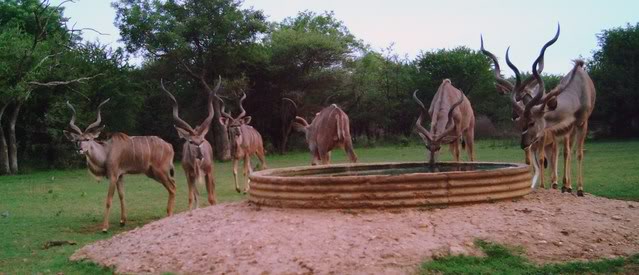The Kudu
The
kudu with its magnificent spiralled horns is one of Africa’s most gracious and handsome antelope. It is the only indigenous antelope at present enlarging its distribution naturally. Wildlife ranching and the private sector also have generally had a positive effect on this species, as it has been widely reintroduced onto private properties within its natural distribution.
Taxonomy notes:
The common name kudu is derived from the indigenous Khoikhoi language of Southern Africa. The scientific name is derived from Greek: Tragos denotes a he-goat and elaphos a deer; Strephis means ‘twisting’ and Keras means ‘horn.
Greater kudu may be distinguished from a similar species, the lesser kudu (
Tragelaphus imberbis), by the presence of a throat mane.
Fig 1: The Kudu
Description:
The Great kudu is a large antelope with tawny colouring and thin, white, sparse vertical stripes. Greater kudu may be distinguished from a similar species, the lesser kudu (
Tragelaphus imberbis), by the presence of a throat mane. The male has long black twisted horns. Females do not have horns
Fig 2: Growth and size charts.
Distribution:
Greater kudus are found extensively throughout Southern Africa, in South Africa, Botswana, Zimbabwe, Namibia, Mozambique and Zambia and even further north in Tanzania, Kenya and parts of Angola.
Fig 3: Distribution in South Africa.
Interesting:
Kudu are highly alert and notoriously
hard to approach. When they detect danger – often using their large, radar-like ears – they give a hoarse alarm bark, then flee with a distinctive, rocking-horse running motion, the male laying back his horns to avoid overhead obstructions.
Their cryptic colouring and markings protect kudus by camouflaging them. If alarmed, they usually stand still and are very difficult to spot.
Fig 4: Dealing with threats.
Habitats and Ecology:
They can be found in a very wide habitat range including hilly areas, slopes of mountains with trees, woodlands, bush thickets, riverine areas, bushveld and wooded savannah areas.The mean home range size is 90-350 ha during wet summer periods and may expand to 600ha during droughts. Predators, such as lions and leopards, African wild dogs, hyenas, and sometimes pythons, hunt kudu and their young.
Fig 5: Natural Predators.
Behavior:
Like many other antelopes, male kudu can be found in bachelor groups, but they are more likely to be solitary. Their dominance displays tend not to last long and are generally fairly peaceful, consisting of one male making himself look big by making his hair stand on end. Males are seen with females only in the mating season, when they join in groups of 5–15 kudu, including offspring. A pregnant female will leave the herd to give birth to a single offspring. She will leave the newborn lying hidden for 4–5 weeks while coming back only to nurse it.
Fig 6: Mother and calf.
Types of herds:
Herds of over 20 usually split up into smaller groups. Young cows remain with their mothers' unit, but young bulls form bachelor groups when they reach sexual maturity, normally at two years. Adult Bulls that have won the right to mate will join herds of females and their young in mating season, but favour other habitats out of the mating season. No territorial spacing exists amongst bulls, but they do show age and hence size-graded dominance hierarchies.
Fig 7: Different types of herds.
Hunting Kudu:
Some of the best kudu hunting methods include stalking their feeding areas early in the morning, or ambushing the bulls as they return from cover and on higher grounds. You can lie in wait at watering holes at midday, still-hunting in thick cover, or tracking. Avoid hunting kudu with . 270 or lower calibre rifles.
If you're after a good kudu trophy, you will want to avoid head and neck shots. Instead, go for the high heart or lung shot.
Fig 8: Shot placement.
The Kudu Trophy measurements:
Horn lengths in the low 50's are fairly common; 55 inches and over can be considered a really good trophy; and 60 inches and over is exceptional. The Eastern Cape Kudu is considered a subspecies of the greater kudu and horns length will be around 5 - 10 inches less than its northern cousin and darker in color.
Fig 9: Skull.
Hunting the Kudu Trophy:
The magnificent horns are spread in beautiful open spirals. There is no scientific proof for claims that narrow horns relate to bush dwelling and wide horns to plains kudu, as the two forms are found in both habitats. However, narrow-horned kudu are more mobile in thickets and are seen moving more frequently in thicker vegetation, whereas a wide horned kudu tends to conceal itself rather than to move. The horns of a kudu are constructed in such away as to give the animal constant eye contact with the tips
Fig 10: The Kudu Trophy
References:
Smithers, RHN, 1983. The Mammals of the Southern African Subregion, 1st edn. University of Pretoria, CTP
Book Printers, Cape Town.
Focus on the Greater Kudu (Tragelaphus strepsiceros), Deon Furstenburg, GEO WILD Consult (Pty) Ltd.
Wikipedia.com,
https://en.wikipedia.org/wiki/Kudu
https://seaworld.org/animals/facts/mammals/greater-kudu/
https://www.ewt.org.za/wp-content/uploads/2019/02/32.-Greater-Kudu-Tragelaphus-strepsiceros_LC.pdf
https://www.safaribookings.com/blog/greater-kudu-facts
https://www.africansky.com/african-...tions/national-parks/kruger-park/mammals/kudu
https://www.awf.org/wildlife-conservation/kudu
http://www.krugerpark.co.za/africa_kudu.html
